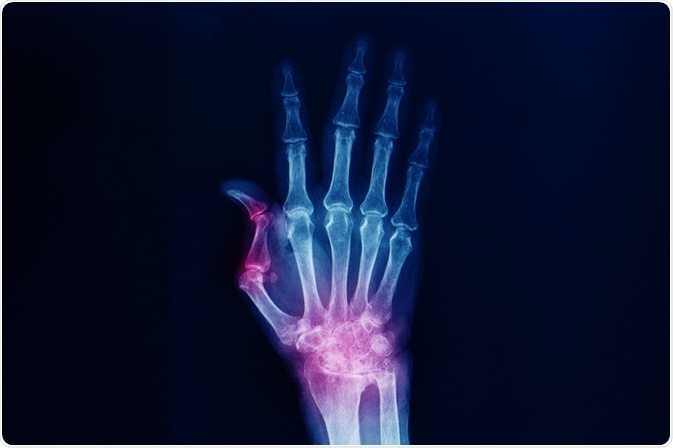A multidisciplinary team approach (i.e. including different healthcare professions such as specialist nurses, physiotherapists, occupational therapists and podiatrists) is often used in the management of patients with diverse rheumatologic disorders. The patient can also be an active member of the team, in order to address and manage all aspects of care.
Nonsteroidal anti-inflammatory drugs (NSAIDs), disease-modifying antirheumatic drugs (DMARDs), corticosteroids, monoclonal antibodies and novel biologic agents are medicaments used in the treatment of rheumatologic diseases. Even though great strides have been made with the chemotherapeutic approach, physical therapy remains an important tool in rheumatic disease treatment.

Image Credit: Yok_onepiece / Shutterstock
Historical overview
In ancient times various treatment modalities were used for rheumatic diseases. Hippocrates and Galen advocated barley water and barley bread for gout, as well as purgative therapy for cases of chronic gout. Emperor Augustus successfully used diet therapy for the treatment of his rheumatism, and various forms of spa therapies were also employed.
The use of uricosuric agents for the treatment of gout began at the end of the 19th century. All of them require good renal function in order to be effective, and the drug named probenecid represents the agent of choice today. The first xanthine oxidase inhibitor successfully used in the treatment of gout in 1963 was allopurinol.
A major milestone in rheumatology was the treatment of rheumatoid arthritis with glucocorticoids in 1948. Albeit they were initially used at high doses for the short-term treatment of flares, low-dose glucocorticoid treatment (less than 10 mg per day) for prolonged periods can have long-term disease-modifying effects.
Another milestone came in 1968 when a folate antagonist methotrexate was used for the first time in the management of dermatomyositis. Since then, methotrexate administrated in low doses became a fundamental drug for the treatment of many rheumatologic diseases due to its efficacy and low toxicity.
A variety of antimalarial medications have been shown to be effective for rheumatologic conditions since quinine was first used to treat systemic lupus erythematosus more than one hundred years ago. Three antimalarials are now employed to treat connective tissue diseases: chloroquine, hydroxychloroquine and quinacrine.
Modern therapeutic approaches
The development of biologic therapies has transformed the way we treat rheumatoid arthritis, as they are able to improve outcomes when non-biologic treatments have failed to achieve adequate disease control. Antibodies directed against specific cell types and certain pro-inflammatory cytokines involved in autoimmune reactions represent the success of rational research programs in the field of rheumatology.
The modern approach of treating gout means that not only acute attacks are managed, but urate-lowering therapy is up-titrated against a specific target level of serum uric acid that is below the saturation point for crystal formation. Current perspectives are shifting towards earlier use of urate-lowering therapy, even at the time of the first diagnosis.
Nonpharmacologic therapy such as patient education, weight loss and exercise still represent the cornerstone of treating osteoarthritis, but due to the chronic nature of the disease, long-term pharmacotherapy is often necessary.
The introduction of biological disease-modifying agents (such as infliximab) was undoubtedly a landmark development in the treatment of rheumatic diseases. Nevertheless, such biologic therapies bring new challenges – namely the high cost of development that has to be included in the price of medication, making these therapies very expensive when compared to non-biologic treatments.
Further Reading